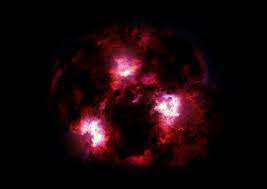The University of Arizona astronomer saw the shimmering blob in new data from the Atacama Large Millimeter Array in Chile. But something didn't match up. The light was on its own in an area without a known galaxy.
"It was very mysterious because the light seemed not to be linked to any known galaxy at all," said Williams, lead study author of a paper published Tuesday in the Astrophysical Journal. "When I saw this galaxy was invisible at any other wavelength, I got really excited because it meant that it was probably really far away and hidden by clouds of dust."
Without meaning to, Williams had found the footprints leading to a massive galaxy from the dawn of the universe 12.5 billion years ago. This means the light took that long to reach Earth.
The researchers likened it to coming upon a set of footprints belonging to a mythical monster, like the Yeti. This is because until now, due to a lack of data, astronomers didn't know they could exist.
The light was likely caused by dust particles that were heated by the stars as they formed inside a galaxy. But the dust clouds themselves obscured the stars, which essentially made the galaxy itself invisible from our view.
"We figured out that the galaxy is actually a massive monster galaxy with as many stars as our Milky Way, but brimming with activity, forming new stars at 100 times the rate of our own galaxy," said Ivo Labbé, study co-author at the Swinburne University of Technology in Melbourne, Australia.
Previously, astronomers had no evidence of massive galaxies from the early universe as they formed. Instead, they spotted some of the largest known galaxies had matured when the universe itself was still young. There was nothing in between to suggest formation.
"Our hidden monster galaxy has precisely the right ingredients to be that missing link because they are probably a lot more common," Williams said.
Given that they discovered one instance of a galaxy like this, now the astronomers need to determine if this was a lucky find or if it's one of many to be discovered.
"These otherwise hidden galaxies are truly intriguing; it makes you wonder if this is just the tip of the iceberg, with a whole new type of galaxy population just waiting to be discovered," said Kate Whitaker, study co-author and assistant professor at the University of Massachusetts Amherst.
When NASA's James Webb Space Telescope launches in 2021, it could be used to investigate these galaxies further.
"JWST will be able to look through the dust veil so we can learn how big these galaxies really are and how fast they are growing, to better understand why models fail in explaining them," Williams said.
CNN
















































